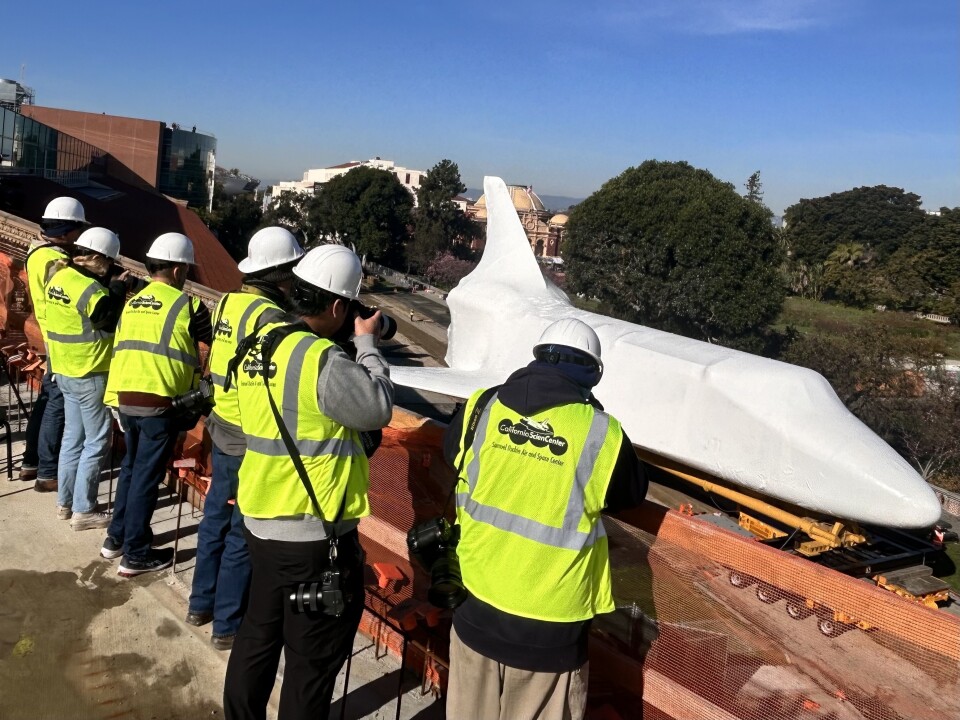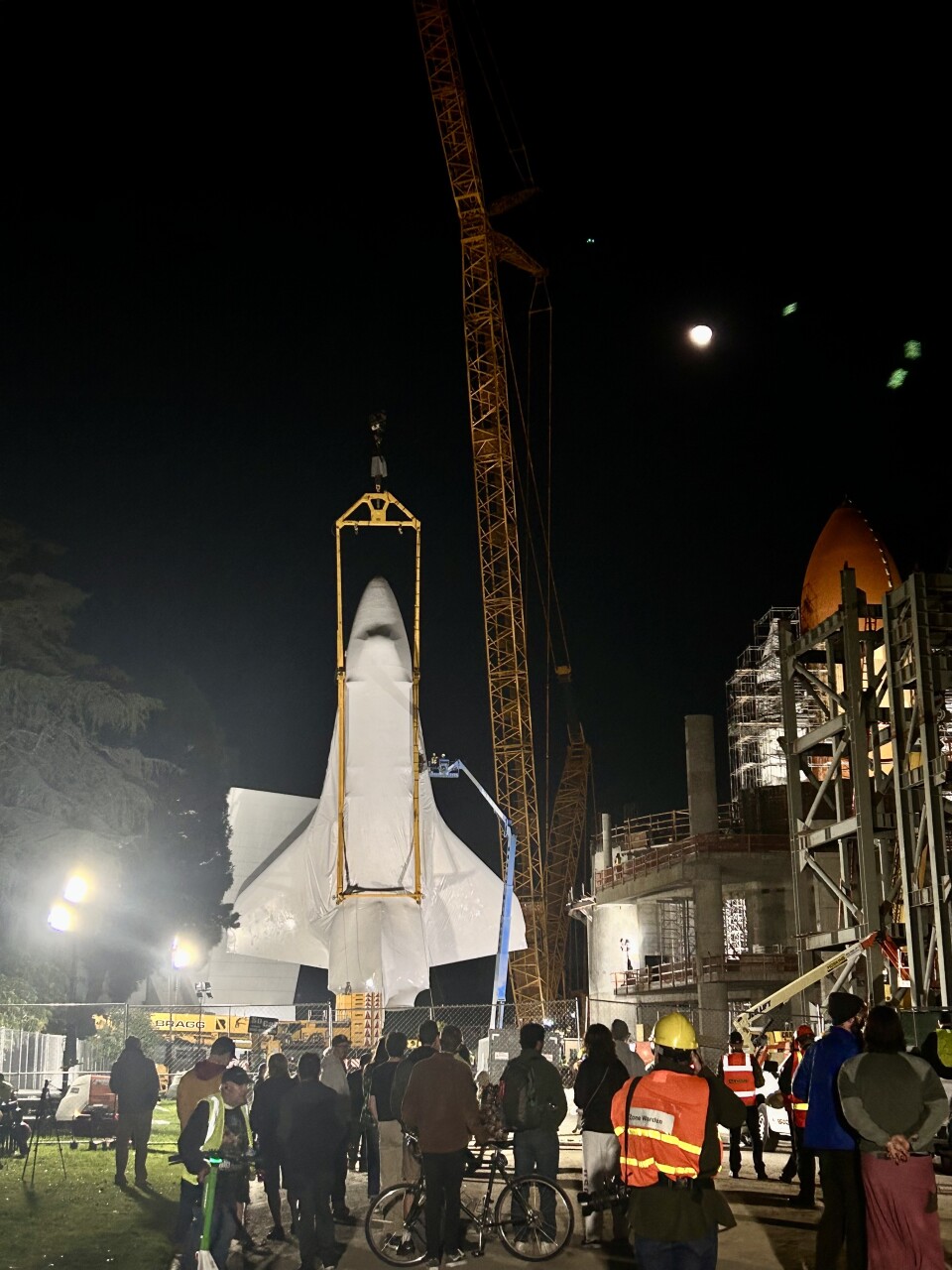Truth matters. Community matters. Your support makes both possible. LAist is one of the few places where news remains independent and free from political and corporate influence. Stand up for truth and for LAist. Make your year-end tax-deductible gift now.
The Final Lift For Space Shuttle Endeavour’s 'Go For Stack' Mission

The California Science Center is putting the finishing touches on its biggest “Endeavour” yet — lifting the space shuttle orbiter into its vertical launch position in the soon-to-be Samuel Oschin Air and Space Center.
Endeavour was put in place overnight Monday, and it’ll soon be attached to the external tank and twin solid rocket boosters in the construction zone, completing the world’s only authentic space shuttle stack.
About the orbiter
Endeavour, which NASA named Orbiter Vehicle-105, was the final orbiter to join the space shuttle fleet.
It was built to replace the space shuttle Challenger, which exploded 73 seconds after liftoff, killing all seven people onboard in January 1986.
Endeavour has been making history since its second mission.
The orbiter took Mae Jemison, the first Black woman, into space on its second trip in 1992. It also helped repair NASA’s Hubble Space Telescope so it could see to the farthest edges of the universe, and was part of the first mission to add a U.S. component to the International Space Station.
About the final move
To prepare for the late-night lift, Endeavour moved from its temporary home for the past 11 years, the Samuel Oschin Pavilion, down the street to the construction site last Friday. It took crews several hours to move the orbiter a little less than 1,000 feet.
Jeff Rudolph, the president and CEO of the California Science Center, told LAist the orbiter isn’t quite as heavy as the external tank that made a similar journey earlier this month, but it is much wider.
With a 78-foot wingspan, crews had to maneuver around trees, signs, and other obstacles on both sides of the street. The orbiter was loaded onto SPMTs — self-propelled modular transporters — so they could slowly but surely make adjustments along the way.

Once the orbiter was parked right in front of the construction zone, it was ready for the big lift.
It was rigged on a 450-foot crane that started moving the orbiter Monday night. It was also connected to a vertical lifting swing, borrowed from NASA, that helped bring Endeavour into launch position a little more than a half hour into the lift.
Half of the lifting swing was released about 20 minutes later, and the orbiter inched its way up towards the stars for the next hour and a half, with a few short breaks for the handful of helicopters that came within the 1-mile no fly zone.
The lift wasn’t advertised to the public, but at least 50 people were watching through the chain link fence on State Drive. George Ruiz told LAist he lives about a block away and wanted to see this once in a lifetime event.
“This is in our backyard,” he said. “I just remember about 10 years ago when the shuttle came into town and it was a big party.”

Clare Davis and her husband were also out watching the big lift. She told LAist they’re not sure if they’ll still be living in L.A. once Endeavour is back on display, but they might come back to Exposition Park just to see it.
“I feel like it's kind of history in the making,” she said. “It's quite an amazing feat of engineering, it's been incredible to watch.”
According to Phillips, there were a few technical challenges during the roughly four-hour lift. For example, he said once the orbiter was in the air, the crane operators were concerned that the angle of the wings wouldn’t clear a nearby building crews on the ground couldn’t see.
Phillips added that NASA had 135 space shuttle missions to practice on, but putting the space shuttle stack together was brand new for the California Science Center.
Once the orbiter was put in place around 2 a.m. Tuesday, it was “soft-mated” with the external tank, which works as the structural backbone of the stack. Phillips said that basically means they put Endeavour on the tank through three points, one at the top and two on the back, and let it sit there to make sure it behaves itself.
If the soft-mate goes according to plan, they’ll then bolt it to the external tank sometime in the next few days, which is bolted to the twin solid rocket boosters. That's considered the “hard-mate” of the orbiter and will complete the space shuttle stack.

Alyson Goodall, the senior vice president of the California Science Center, told LAist this “Go For Stack” vision has been decades in the making, and it's really fulfilling watching it come to life.
“The leadership of the Science Center dreamed of this, and we have a rendering back in 1992 showing a space shuttle in launch position, and that was before Endeavour even launched itself,” she said.
What’s next
Now that Endeavour is lifted into its new permanent home, the California Science Center has to finish constructing the rest of the Samuel Oschin Air and Space Center.
Crews will add scaffolding and plywood barriers around the entire space shuttle stack to make sure it stays safe during construction, Phillips added.

The new addition, which is a 200,000 square foot expansion of the museum, will then finish being built around the 20-story Endeavour display.
The Samuel Oschin Air and Space Center will include 100 exhibits, more than a dozen aircraft displays, and 100 authentic artifacts that explore the science of flight and space exploration in three different zones — Air, Space, and Shuttle.
Diane Perlov is the senior vice president for special projects at the California Science Center. She told LAist the Shuttle gallery will feature a 3-minute introductory film that was made in conjunction with J.J. Abrams’ production company Bad Robot.
“When they finish the film, there'll be some mist that goes in the gallery, and it'll be like a launch is happening,” she said. “Then all of a sudden, the screen will rise, and people will look out, and they will see the real stack.”
Perlov added that the space shuttle stack has been placed on a huge seismic isolator that will protect it from being damaged or falling over in an earthquake.
The California Science Center also needs to secure the rest of the funding first. They’re still about $40 million short of their $400 million goal.
You can help us build Endeavour's permanent home at the Science Center—the future Samuel Oschin Air and Space Center—and inspire all who will walk through its doors by making a gift to the EndeavourLA Campaign at https://t.co/XWwbRHTSBZ.
— CA Science Center (@casciencecenter) January 29, 2024
Phillips said no gift is too small. Plus, if you sign up to sponsor one of the thermal tiles on the orbiter, your name will be featured in that exhibit.
“There are opportunities for people to get involved in this project,” Phillips said. “I mean, meaningfully involved at virtually every level. Kids can bake cookies, we'll take it."
The Samuel Oschin Air and Space Center doesn’t have an opening date yet, but construction is expected to take at least a few years.
“So [Endeavour] will be going away for a while, but it's for the better,” Rudolph said.








